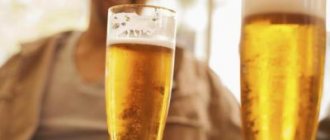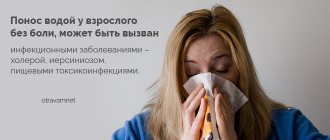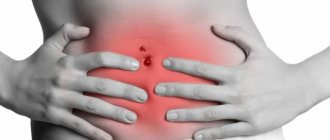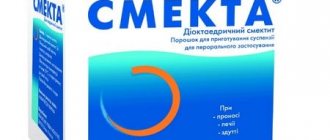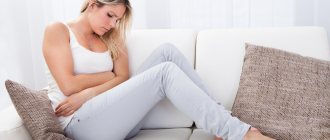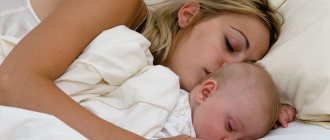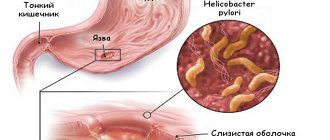In addition to abdominal pain, the victim is bothered by nausea and vomiting. Most doctors are inclined to believe that pylorospasm causes abdominal cramps due to significant nervous strain and constant stress, neurotic disorders. Not only the signs of the disease are dangerous, but also their consequences: due to the lack of proper digestion of food, the body does not receive the required amount of nutrients, vitamins and microelements, the patient quickly loses weight, his immunity decreases, and the risk of other diseases increases.
Inflammation of the gastric mucosa and abdominal pain after eating
Inflammation of the tissues of the mucous membrane of the stomach or duodenum. Pain during inflammatory processes in the area of these parts of the digestive system indicates a person has gastroduodenitis. It is the source of severe and prolonged periodic colic in the lower abdomen, mainly on the left/right side, occurring immediately after filling the stomach with food and sometimes accompanied by belching. Periodically, unpleasant sensations are localized in the navel area.
Your child has diarrhea after eating
If you experience frequent diarrhea after eating, you should find out the reasons before taking medications. To do this, it is recommended to consult a specialist. The full functioning of the digestive system depends on functional and pathological reasons.
Medical indications
Diarrhea after eating can occur once or recur periodically. In the latter case, chronic indigestion occurs. Treatment is prescribed after determining the exact cause of diarrhea. More often this symptom is caused by viruses and microbes. The doctor may make the following diagnosis:
- dysentery;
- salmonellosis;
- acute gastroenterocolitis.
With such diseases, diarrhea after eating is accompanied by high fever and weakness. A child or adult experiences vomiting, dizziness, and general weakness. The first symptoms may appear within a few hours or after 5-7 days. The incubation period depends on the number of microbes entering the body of a child or adult.
To prescribe a course of treatment, pathogen secretions are examined and their type is determined. Viral pathologies are characterized by the presence of signs of acute respiratory infection and its rapid transmission.
Diarrhea after each meal can occur if the digestion process is disrupted. Food consumed by a person moves through the digestive tract, breaking down into small substances.
Fats, proteins, carbohydrates, and then simple substances (amino acids) are first formed.
This process is directly influenced by the following substances and factors:
- liver and stomach enzymes;
- quality and quantity of food eaten;
- condition of the gastrointestinal mucosa.
Diarrhea immediately after eating can occur due to climate change, the composition of the water consumed, and the nature of the diet.
Types of Digestive Disorders
Therapy is prescribed taking into account the type of diarrhea:
The first symptom is caused by pathogenic microbes and viruses. When toxins are released, the permeability of the mucous membrane increases. Salt and water appear in the stool.
Bloody diarrhea in adults and children occurs against the background of ulcers and ulcer-like formations. Due to the destruction of the upper layer of the intestine, various changes in blood vessels occur, and blood appears in the stool. If an ulcer is suspected, sigmoidoscopy is indicated.
If such symptoms are not eliminated in a timely manner, the process may progress to a chronic stage.
Diarrhea after each meal can be a consequence of nervous and emotional stress, allergies to a certain food product, surges in blood pressure, or vitamin deficiency. There are 4 mechanisms for the development of diarrhea:
- the movement of intestinal contents is disrupted;
- the permeability of the intestinal walls increases;
- a secret is produced;
- osmotic pressure changes.
The above processes are interconnected. But each pathology occurs individually.
Loose stools in infants
Diarrhea in infants is often associated with an intestinal infection. In this case, the symptom in question appears as long as the disease lasts. The secondary causes of diarrhea are:
- food poisoning;
- immaturity of the enzyme apparatus;
- starvation;
- inflammatory processes in the ears and larynx;
- early introduction of complementary foods;
- worms;
- dysbacteriosis;
- allergy to formula or milk;
- stress;
- drug poisoning;
- unsanitary conditions;
- teething.
Particular attention should be paid to infants who exhibit additional symptoms (loss of appetite, sour-smelling feces and diaper rash). Newborn babies may experience diarrhea in the form of colitis or enteritis.
The latter pathology develops against the background of acute intestinal infection, chronic gastrointestinal pathology, invasion and dysbacteriosis. In infants, enteritis manifests itself against the background of staphylococcus. It is often associated with overeating and disordered diet. With enteritis, water, potassium and sodium salts are excreted in the stool. This symptom leads to rapid dehydration of the body.
When a child has colitis, the temperature rises, the skin turns pale, and weakness is observed. Stool, unlike enteritis, is less abundant. But there is mucus and blood in the stool. Experts include intestinal infection, which is combined with acute gastritis, as the causes of the development of acute colitis. Rarely, such a symptom manifests itself against the background of intolerance to certain food components.
Chronic colitis is the outcome of the acute form. It can also manifest itself against the background of parasitic and helminthic diseases, as a result of constant violation of the diet, due to irrational use of antibiotics and laxatives. The causes of the development of secondary colitis are endocrine diseases and pathologies of the central nervous system.
To eliminate the symptoms of the pathology, drug therapy is indicated. The child is prescribed antibiotics (Mexaform), enzymes (Pancreatin), and analgesics (Methacin). If remission of chronic colitis is observed, then physiotherapy is used.
If therapy is ineffective or the consequences of diarrhea develop after eating, surgical intervention is indicated.
Eating different foods
Morning diarrhea after eating in a child is a common occurrence. To identify the cause that provoked this symptom, you will need to consult a pediatrician. A similar phenomenon can occur if children's dishes are not sterilized sufficiently. Therefore, the child’s body does not perceive food.
Constant diarrhea after breakfast indicates the development of dysbiosis.
In this case, you will need to consult an allergist, gastroenterologist and infectious disease specialist. To restore digestion, you will need to adjust your diet. The baby must be given fermented milk products. The child may be prescribed Bifidumbacterin.
Diarrhea in an adult can occur after eating spicy and sour foods. Belching, a feeling of heaviness, abdominal pain, heartburn appear 60 minutes after eating. Similar symptoms have been observed for a long time. Such diarrhea after eating must be treated promptly when the first symptoms appear. Otherwise, the adult patient will begin to lose weight.
Since the main cause of diarrhea after eating is considered to be improper and irregular nutrition, therefore, to get rid of it, a strict diet is indicated. It will improve the functionality of the gastrointestinal tract. You should not eat fried, fatty or spicy foods. Experts include peritonitis, septic processes, toxic and infectious shock as the consequences of diarrhea.
Prevention methods
To prevent diarrhea in children and adults, it is recommended to eat properly, promptly treat acute intestinal infections, worms and dysbacteriosis, and get vaccinated.
Secondary prevention of diarrhea (especially with colitis and enteritis) means preventing recurrence of diarrhea after eating. Young and adult patients should be under the supervision of a pediatrician/general practitioner or gastroenterologist.
Such patients are indicated for preventive courses of drug treatment (3 times a year).
Since diarrhea after eating develops for various reasons and against the background of intestinal diseases, only a specialist can make an accurate diagnosis (after a complete examination of the patient). If diarrhea is observed for more than 2 days, and symptoms of intoxication appear, then urgent consultation with a specialist will be required.
Diarrhea after eating
Disturbances in the proper functioning of the digestive system can be associated with both functional and pathological reasons. They often take a person by surprise and require qualified medical care.
Causes of diarrhea after eating
You can talk about indigestion, diarrhea or diarrhea if you have bowel movements 3 or more times a day. This may be a manifestation of a number of pathological conditions, including those of an infectious nature. Diarrhea in an adult can be one-time or chronic.
Among the causes of functional diarrhea, biological agents come first:
The body strives to free itself from bodies and substances that poison it.
Diarrhea immediately after eating can be a consequence of:
- foodborne toxoinfection;
- Escherichiosis;
- acute gastroenterocolitis;
- dysentery;
- salmonellosis, etc.
In addition to diarrhea, infection is accompanied by:
- general malaise;
- elevated temperature;
- dizziness;
- vomiting;
- weakness.
The duration of the incubation period for different pathogens can vary from several hours to a week. It depends on factors such as the ability of the microbe to produce toxins and their quantity. The diagnosis can be confirmed as a result of bacteriological analysis, where, in addition to isolating the pathogen, its concentration in a unit of biomaterial is also determined.
If diarrhea is caused by a viral infection, then the person is concerned about symptoms characteristic of ARVI.
Drug treatment will help to cope with a painful condition provoked by infectious agents.
Digestive disorders
In second place among the causes of diarrhea is impaired digestion.
The natural process of breaking down polymer molecules into smaller components can be hindered by the following factors:
- problems with the gastric mucosa;
- quality of consumed products;
- hormonal disorder;
- neoplasms;
- activity of enzymes of the stomach pancreas liver;
- amount eaten. Children most often suffer from overeating. The immature digestive system of the child’s body is not able to digest a large amount of food and tries to get rid of it faster, which provokes acute diarrhea in the child after eating.
Psychological factor
Neurogenic diarrhea is also possible. It occurs during a prolonged stressful situation, for example, during exams. Diarrhea due to nervousness is only part of a complex symptomatology, the consequences of which can be neuroses and vegetative-vascular dystonia.
Dysbacteriosis
Another cause of functional diarrhea may be dysbiosis, which develops against the background of long-term use of antibacterial compounds or poor nutrition, as a result of which the balance of the intestinal microflora is disrupted.
- Diarrhea can provoke pancreatitis, which is accompanied by hypermotor dyskinesia of the bile ducts, which increases peristalsis of the digestive canal.
- Diarrhea can be caused by changes in water, food or climate. Then they talk about “travelers' diarrhea.”
- Eating poor quality food causes intestinal upset. This diarrhea lasts 1-2 days. If the concern in the form of loose stools appears to be longer lasting, you should immediately consult a doctor.
Diarrhea can develop:
- after prolonged exposure to the sun;
- as a consequence of a deficiency of certain vitamins;
- after taking medications, especially those aimed at improving the functioning of the gastrointestinal tract. Most of them are characterized by a side effect in the form of diarrhea after eating;
- like an allergy to a certain product;
- as a result of changes in blood pressure.
Diarrhea immediately after eating is not only unpleasant and causes a lot of inconvenience. Its danger lies in tissue dehydration and leaching of useful minerals from the body, especially potassium and magnesium cations. The phenomenon of dehydration is especially dangerous for children's bodies.
What to do if you have frequent loose stools and stomach pain after eating?
If pain occurs while the patient is eating, food intake should be stopped. To lavage the stomach, you need to drink more liquid (2-3 glasses). Before being examined by a specialist, the patient must adhere to a strict diet. To alleviate painful symptoms, it is allowed to take no-shpa or drotaverine. Being caught off guard by abdominal pain, accompanied by diarrhea after eating or at other times, people are confused and do not know how to behave correctly. It must be remembered that the sudden onset of painful symptoms may indicate the progression of serious diseases, and therefore requires a mandatory examination of the patient by a doctor, who will order an examination and make an accurate diagnosis, prescribing, if necessary, drug treatment.
If over time the pain does not go away and intensifies, the body temperature rises, nausea and vomiting are present, it is important to call an ambulance without delay or take the patient to the doctor yourself. If you experience stomach pain accompanied by diarrhea, there is a high probability of food poisoning. The patient's defecation is disrupted, diarrhea and severe nausea begin, accompanied by gagging, turning into vomiting.
In case of prolonged and severe diarrhea, the patient should be given plenty of fluids and call a doctor immediately. It is necessary to pay attention to the composition of stool, namely: the presence of mucus, pus or blood impurities in it. As a result of severe diarrhea, the human body quickly becomes dehydrated, which manifests itself through drowsiness, fatigue and weakness, and dizziness.
Why do I have diarrhea immediately after eating and how to treat it correctly?
The situation when you immediately want to go to the toilet after eating can be caused by various factors.
Loose stools are a consequence of functional disorders of the digestive process. Diarrhea after eating occurs due to the accelerated movement of a bolus of food without proper absorption. A single bowel disorder will not harm the body. If diarrhea becomes chronic, the cause must be urgently determined. Otherwise, the heart, kidneys or other organs will suffer from systematic dehydration and demineralization.
Development mechanism
During the digestion of food, essential vitamins and minerals are absorbed into the blood. This process begins in the small intestine. Active water-salt exchange occurs here. Any irritant can disrupt the sequence of biochemical reactions and provoke increased peristalsis of the gastrointestinal tract.
To quickly transport contents through the digestive tract, a large volume of liquid enters the small intestine from blood plasma. Water comes here along with salts dissolved in it.
The intestines become overfilled with fluid “squeezed out” from other organs and tissues. The bolus of food with an abundance of water quickly passes into the large intestine.
This process leads to an uncontrollable urge to go to the toilet, which begins immediately after eating.
The lost volume of fluid with salts leads to disruption of metabolic processes. Especially due to the emergency evacuation of food, the heart and kidneys suffer, which lose magnesium, potassium and other important elements.
Disturbances in the digestive process can occur not only in the upper gastrointestinal tract, but also in the large intestine. In this case, the body loses less fluid.
The inner lining of the small intestine is covered with many microscopic villi. Everything that is necessary and useful is absorbed into the blood through them, and the excess is formed into feces.
Main reasons
Diarrhea after eating is often caused by impaired intestinal motility. Reasons for diarrhea due to which food tends to leave the gastrointestinal tract:
- Stale or unusual food products. The body gets rid of pathogenic microorganisms if a person has eaten something spoiled. Poisoning manifests itself as pain in the abdomen and diarrhea immediately after eating. Switching to a new menu (for example, while traveling) provokes loose stools due to a lack of enzymes to break down exotic foods. In a child under 3 years old, new foods often cause intestinal upset, so their introduction into the diet begins in small portions.
- Imbalance of intestinal microflora. A lack of beneficial bacteria leads to premature evacuation of food. Intestinal dysbiosis is a consequence of taking antibiotics and poor nutrition. A deficiency of beneficial bacteria leads to chronic diarrhea, which occurs immediately after eating or an hour later.
- Bacterial or viral infection. Pathogenic microorganisms enter the body with food or water. The intestinal mucosa becomes inflamed and damaged. As a result, it releases exudate, mucus, and irritating organ walls. Salmonellosis leads to severe inflammation. Bacteria damage the deep layers of the mucosa until blood and pus are released from the epithelium. In an inflamed intestine, absorption is impaired and peristalsis accelerates. Particles of excretions cause diarrhea after every meal.
- Functional disorders of the nervous system. The increased speed of movement of the food bolus occurs due to neurogenic stimulation. Since digestion is controlled by the autonomic nervous system, in a stressful situation, natural metabolism is disrupted. This leads to the fact that after eating you immediately want to go to the toilet.
- Food intolerance. The gastrointestinal tract is urgently cleared of allergens. Peristalsis increases, which leads to stool liquefaction.
- Diseases of the digestive system. In diseases of the liver and gall bladder, the secretion of electrolytes and intestinal juice increases. Gastritis with low stomach acidity is characterized by a lack of secretory fluid necessary for the primary processing of the contents. Food enters the small intestine without the necessary preparation, causing diarrhea.
- Deficiency of enzymes for digesting food. The disorder is associated with pancreatitis, an inflammation of the pancreas.
- Hormonal imbalances. Lack or excess of active substances produced by the thyroid and pancreas glands lead to digestive upset after eating.
- Binge eating. Large portions put a strain on the digestive system. The body tries to get rid of excess fluid as quickly as possible by sending water reserves to the intestines. Diarrhea after eating in this case is a protective reaction against an overwhelming load on the gastrointestinal tract.
- Eating fatty foods. After a meal with excessive fat content, intestinal upset often occurs. Products with a high content of the substance: fried meat, lard, confectionery products with cream. A sudden urge to defecate after eating these foods may appear an hour after eating. During this period, food begins to move into the small intestine. Excess fat is poorly absorbed by its walls, causing diarrhea.
- Taking laxatives for constipation.
What diseases cause diarrhea?
Intestinal upset after eating may indicate pathologies:
- hyperthyroidism;
- colitis;
- enteritis;
- gastritis;
- stomach and duodenal ulcers;
- rotovirus;
- salmonellosis;
- norovirus;
- irritable bowel syndrome;
- pancreatitis;
- hormone-dependent tumors;
- parasitic infection, etc.
In adults and older people, diarrhea often occurs due to changes in blood pressure. These two states are interconnected. When pressure increases, brain neurons responsible for regulating bowel movements are stimulated. Diarrhea can also be caused by blood pressure medications.
How to determine the source of the problem
A single diarrhea after eating is not harmful to health. If diarrhea becomes a constant occurrence, vitamin deficiency and chronic diseases may develop.
The source of diarrhea can be determined by the characteristics of the stool. The consistency of the stool, color, and the presence of inclusions play a role in making a diagnosis.
Watery greenish discharge in adults is a sign of infectious diarrhea. Most often, the causative agent of the disease is rotovirus, norovirus. Microbes multiply in the intestinal epithelium, which causes a decrease in enzyme activity. Microvilli on the surface of the small intestinal mucosa have the ability to absorb molecules of a certain size.
Since the activity of enzymes decreases under the influence of viruses, disaccharides are not able to break down into monosaccharides - molecules of the required size. Undigested food along with liquid quickly passes into the large intestine, causing diarrhea after eating.
Particles of blood and mucus in the stool are a symptom of a bacterial infection. Common causative agents of this type of diarrhea are staphylococci and salmonella. The infection may be accompanied by vomiting and increased gas production.
Greasy stool with a pungent odor indicates that the small intestine is not coping with its functions. Fats are not absorbed, so they are excreted directly in the feces. This phenomenon is often associated with poor nutrition and excessive consumption of heavy foods.
If the source of infection is the stomach or small intestine, the stool is always large, watery, and may contain particles of undigested food.
With exacerbation of erosive gastritis and stomach ulcers, the stool has a tarry consistency. The feces are colored black because the blood, moving through the lower gastrointestinal tract, has time to clot.
Diseases of the stomach and duodenum can worsen due to stress, poor diet, and irritation with medications. Inflammation of the mucous membrane is often accompanied by diarrhea after eating, belching, and heartburn.
When diarrhea after eating is caused by diseases of the colon, the urge to go to the toilet is difficult to control, since the lesion is located close to the anus. The stool is mushy and the volume of feces is small.
Mucus and pus in the stool indicate inflammation of the colon - colitis. Inflammation is accompanied by pain in the lower abdomen, localized on the left. If there is blood in the stool, this is a sign of ulceration.
Necessary tests
To find out the cause and begin treatment for diarrhea that occurs after eating, contact a gastroenterologist. Go to the doctor if diarrhea does not go away for more than 2 days. The list of diagnostic procedures depends on the accompanying symptoms.
The doctor may refer for research:
- analysis of stool, blood, urine;
- gastroduodenoscopy;
- sigmoidoscopy, colonoscopy;
- Ultrasound of the abdominal cavity;
- food allergen test.
To determine the nature of diarrhea, stool samples are taken to check for bacteria, viruses, and helminthic infestations.
Drug treatment
Chronic diarrhea after eating exhausts a person, leads to dehydration and general weakness. To prevent undesirable consequences, you need to take measures immediately after detecting a problem:
- drink plenty of fluids (clean water is best);
- take medications to restore electrolyte balance - Regidron, Gidrovit;
- use sorbent agents to remove toxins from the body - Activated carbon, Smecta, Enterosgel;
- follow a gentle diet.
If diarrhea is caused by allergenic foods, they are excluded from the diet. In addition to saline solutions and absorbents, they take antihistamines - Zodak, Suprastin, Fenistil.
The treatment regimen for the treatment of chronic diarrhea is selected individually, depending on the type of underlying disease. Based on the results of the examination and examination of the patient, the doctor may prescribe:
- Drugs that slow down intestinal motility based on loperamide - Imodium, Lopedium, Diara. These medications should not be taken for intestinal infections, blood in the stool, or peptic ulcers.
- Anti-diarrhea medications that normalize intestinal microflora - Bifidumbacterin, Linex, Bifiform, Acipol. Such remedies are effective in eliminating dysbiosis.
- Anthelmintic drugs for parasites - Dekaris, Pirantel. They are prescribed when roundworms and pinworms are detected in feces.
- Antibiotics if diarrhea is caused by a bacterial infection. Treatment is carried out with Levomycetin, Sumamed, Amoxicillin.
- Sedatives – Novo-passit, Afobazol, Persen. They are used for diarrhea that occurs due to nervousness.
Diet for chronic diarrhea after eating
To restore intestinal functions and eliminate intestinal irritation, you need to follow a therapeutic diet. For one-time diarrhea, it is enough to adhere to a special diet for 2-5 days. Chronic diarrhea is treated with a diet for 2–4 weeks.
Fried, salted, smoked, and spicy dishes are excluded from the menu. During the diet you should not eat:
- canned food;
- sweets;
- fresh fruits;
- milk;
- insoluble fiber (seeds, nuts, muesli).
These foods can lead to renewed diarrhea because they are difficult to digest.
During the diet, they consume well-cooked porridges, broth-based soups made from cereals, vegetables, and chopped lean meats.
Folk remedies
Rice water and strong tea have astringent properties. To relieve inflammation, you can prepare a chamomile decoction - 1 teaspoon of crushed flowers per glass of boiling water. The drink is infused for 20 minutes and drunk 3 times a day.
Effective folk remedies for diarrhea after eating:
- eat buckwheat porridge with water in the morning without adding salt - such a breakfast will relieve loose stools throughout the day;
- decoction of oak acorns - thanks to its astringent properties, the drink relieves diarrhea associated with irritable bowel syndrome and nervous tension;
- black peppercorns - 4-6 pieces should be eaten before bed.
Diarrhea after eating should not be ignored. Especially if this symptom becomes a permanent occurrence.
We recommend: What to do and what to feed a 2-year-old child with diarrhea?
Source: https://gastrot.ru/diareya/ponos-posle-edy
Food allergies and abdominal pain and diarrhea (diarrhea), nausea
Sometimes the pain begins after food enters the stomach and urticaria occurs along with it. Therefore, if rashes or other allergic reactions appear on the face, food allergies should be ruled out first. This reaction to the food consumed is displayed on the skin if this person is allergic to certain foods. In this way, the stomach reacts to the effects of allergens that trigger inflammatory processes inside it. The body makes attempts to naturally cleanse itself of the irritant that caused inflammation and discomfort; this manifests itself through pain in the upper or lower parts of the abdominal cavity, sometimes in the middle.
Skin rashes appear because part of the food that caused the allergy has already managed (partially or completely) to be absorbed into the blood, which is externally observed as the appearance of irritation. Food allergies are often inherited; there are often cases when it becomes a companion or the result of chronic diseases, deviations from the normal functioning of the digestive system and dysbiosis, and in young children - a transfer from breastfeeding to artificial nutrition and the introduction of complementary foods.
Toxic infection and lower abdominal pain, diarrhea, nausea and diarrhea
Why does colic appear and diarrhea begin in case of poisoning (toxic infection)? The vast majority of known examples of poisoning occur due to the consumption of low-quality or expired food. This often happens due to negligence, and sometimes as a result of neglect of hygiene rules. Through loose stools and lightheadedness, nausea and vomiting, the body naturally tries to get rid of the detected toxins and other poisonous substances that have penetrated the stomach and intestines after using low-quality products.
Diarrhea, pain in the organs of the digestive system and signs of nausea torment the patient because, as a result of digestion, the components of poor-quality food are absorbed into the blood, thereby poisoning the body. Obvious symptoms of poisoning are nausea and vomiting, general weakness, drowsiness, fever, and less commonly, changes in body temperature, and impaired bowel movements. In case of severe poisoning, toxic shock may occur, accompanied by a decrease in blood pressure. Under its influence, a person’s heart rate may increase and confusion may occur.
The child has diarrhea after every meal
Intestines » Symptoms » The child has diarrhea after every meal
Diarrhea (the medical term is diarrhea) is a bowel disorder in children. Diarrhea is a common digestive disorder that occurs due to many reasons.
In children of the first year of life who are breastfed, the normal frequency of stools is 5-6 times a day.
The stool is usually yellow, homogeneous, mushy, without pathological impurities (mucus, streaks of blood).
In infants who are bottle-fed, stool is 3-4 times a day, possibly with a brown tint. Children from one to two years old have brown stools 1-2 times a day.
For older children, usually once a day.
The anatomical and physiological characteristics of the digestive tract in children predispose to acute digestive disorders and the rapid development of such serious complications of diarrhea as dehydration and electrolyte imbalance in the body. Any diarrhea when the excretion of stool in an amount of more than 10 g per kg of a child’s weight per day is already a clinical manifestation of impaired absorption of water and electrolytes in the intestines.
Diarrhea in children can be due to bacterial and viral infections and as a complication after treatment with antibiotics. And they can also be chronic, this is when stool occurs more than 3 times and lasts more than 3 weeks.
Diarrhea may be the first symptom of dysentery. With this disease, it is especially important to provide assistance immediately.
Functional diarrhea occurs - this is when the child’s condition is not disturbed and is not accompanied by impaired physical development (weight and height gain). Since diarrhea provokes dehydration in children in the first two years of life, it is necessary to be attentive to the child’s condition in case of bowel irregularities and promptly contact the local pediatrician.
First of all, in case of acute onset of diarrhea in a child, against the background of deteriorating health, it is necessary to think about an acute intestinal infection.
The most common bacterial infections that cause diarrhea are salmonella (salmonellosis), Shigella Zone, Flexner (causing dysentery), E. coli with pathogenic properties, Campylobacter, pathogenic Staphylococcus aureus (causing food toxic infection).
The route of infection with a bacterial infection is mainly fecal-oral (dirty hands, expired products, contact with a patient with an acute intestinal infection), but the water route is also possible.
A viral infection can also cause diarrhea: this is a rotavirus infection, it occurs frequently and everywhere (about 80% of diarrhea in children is caused by rotaviruses), and occurs in the form of gastroenteritis.
Rotavirus infection is severe in children under the first 2 years of life due to rapid dehydration. Enterovirus infection in young children is also a cause of severe gastroenteritis.
Amount of liquid required for oral administration:
Amount of liquid in ml200 - 400 ml
You must immediately contact your local pediatrician to prescribe treatment.
Chronic diarrhea is observed in many diseases that impair intestinal motility. Conventionally, they can be divided into two groups:
- Diseases in which the digestion of nutrients in the small intestine is impaired due to insufficiency of digestive enzymes: - this is a deficiency of pancreatic enzymes, accompanies diseases of the pancreas - cystic pancreas, cystic fibrosis, congenital pancreatic hypoplasia, chronic pancreatitis, enterokinase deficiency, diabetes mellitus; - this is a deficiency of bile acids (maybe after surgery on the small intestine, with Crohn's disease);
- this is dysbacteriosis.
- Diseases in which the absorption of nutrients in the small intestine is impaired: - this is a malabsorption of carbohydrates - lactase deficiency, glucose-galactose deficiency, fructose deficiency; - this is damage to the intestinal tract due to food allergies;
Celiac disease is a disease in which the mucous membrane of the small intestine is damaged by the protein contained in cereals (rye, wheat, oats, barley) - gluten.
Diarrhea for more than 2-3 weeks, a child’s weight loss are serious symptoms of diseases that cause chronic diarrhea, for which it is important to early diagnosis and timely treatment, since diarrhea is accompanied by a loss of not only fluid, which is vital, but and loss of protein, electrolytes, minerals and other vital components. Therefore, it is necessary to seek qualified medical help as early as possible in case of such disorders of the child’s body.
There is also stool disorder against the background of a favorable state of the body, when the general state of health does not change, the child does not lag behind in weight, and there are no other disorders. More often in children from 1 to 4 years old, diarrhea occurs after almost every meal (3-5 times a day), often for a long time.
The stool is brown, contains undigested food particles, and there are no pathological impurities.
Such diarrhea is more often associated with excessive consumption of fruit juices, carbonated drinks, as well as food intake with a lack of fats and proteins and with an excess of carbohydrates, such as: gingerbread cookies, cookies, cakes (children under three years of age should not eat them), sweets and things like that!
Treatment of functional diarrhea in children is the normalization of the consumed volume of liquid to 90 ml/kg of body weight per day, mainly reducing the volume of juices, carbonated water, reducing the intake of the above carbohydrates, replacing them with natural fruits and vegetables. As well as adding proteins and fats to the child’s diet.
10-15% of children in adolescence experience diarrhea with periodically repeated abdominal pain associated with impaired intestinal motility and the individual characteristics of the teenager. Such disorders are more common under stress.
The pain is most often paroxysmal in nature, in the umbilical region, combined with bowel disorders up to 3 times a day. Pain subsides after defecation. The child’s condition and well-being do not suffer; the children do not lag behind in weight.
After excluding an infectious factor or organic causes of diarrhea, in this case, parents, together with the doctor, should find out from the child the cause of this condition. And it is possible to limit milk, fats, and fiber in your diet.
Take enzyme preparations (digestal, enzistal, etc.). For severe pain No-shpa, papaverine. For frequent bowel movements - loperamide (Imodium). Treatment should be carried out only after examination and examination by a doctor and according to his recommendations.
Source: https://kishechnik-zhivot.ru/simptomy/u-rebenka-posle-kazhdogo-priema-pishhi-ponos
Salmonellosis and frequent loose stools, nausea and abdominal pain
Salmonellosis is a disease belonging to intestinal infections. The source of its occurrence is pathogenic microorganisms, bacteria and viruses that enter the human body through the gastrointestinal tract. It is inappropriate to draw analogies between the deterioration of stool that occurs with food poisoning and intestinal infections. In the second case, the problem is hidden in the effects of viruses and harmful bacteria on the body, while in the first it is associated with food consumption. Salmonellosis has a long incubation period; its symptoms do not appear immediately, but only some time after the onset of the disease.
Abdominal pain due to pancreatitis
The first signs of pancreatitis are abdominal pain and profuse diarrhea. In the chronic form of the disease, bowel dysfunction appears due to the development of pathologies of the pancreas, so there is no need to look for the causes of diarrhea in external stimuli (poor quality food or environmental influences). Chronic pancreatitis stimulates the launch of degenerative processes and disruption of the normal processing of substances necessary for the body that enter it with food.
In patients with pancreatitis, diarrhea and cramps begin one to two hours after the feast. Often these symptoms, as well as nausea followed by vomiting, overtake a person who has developed pancreatitis at the mere smell or mention of fatty foods.
What to do if you have stomach cramps and diarrhea
Depending on what causes the pain associated with diarrhea, a set of medications is selected for patients. Important for diagnosis are all the signs that accompany stool liquefaction: nausea, vomiting, pain, bloating, a feeling of constant movement in the abdomen.
The following types of medications are used to relieve unpleasant symptoms:
- Enterosorbents . Required to take if an adult has had stomach churning for several days and has loose stools. With the help of adsorbents, intoxication in the body is reduced, after which pain in the intestines is eliminated. Enterosgel, Activated carbon, Smecta are suitable for an adult patient.
- Probiotics . When the cause of severe stomach cramps is dysbacteriosis caused by taking medications or poor nutrition, you cannot do without the use of probiotics. Bifiform, Bifidumbacterin, Linex are products with active bacterial components. They will help restore the normal balance of intestinal flora and eliminate torsion and gurgling in the stomach.
- Stool-fixing drugs . Immodium and Loratadine are suitable for providing urgent care to a patient. These medications reduce the contraction of intestinal smooth muscle, which helps reduce the urge to defecate and eliminate discomfort.
- Antispasmodics and painkillers . If the stomach twists too much, the patient cannot tolerate the pain, the gastroenterologist prescribes No-shpa, Drotaverine, and other painkillers.
- Sedatives . For traveler's diarrhea and other emotional shocks that provoke diarrhea, patients are also recommended to take medications to relieve anxiety: Persen, Sedavit.
- Antimicrobial agents . Sometimes the cause of diarrhea is an intestinal infection. In this case, patients need to take antimicrobial drugs: Phthalazole, Nifuroxazide.
- Antibiotics . When the stomach has been twisting for several days, or loose stools are tormented due to a bacterial infection, a specialist may prescribe antibiotics to the patient.
Abdominal pain and frequent loose stools may be a sign of a dangerous disease. Therefore, before you start taking antidiarrheal medications, you should consult your doctor.
Causes of colic and diarrhea in diseases of the liver and gall bladder
Unpleasant sensations spreading throughout the abdomen and liquid stool are characteristic of diseases affecting the liver and bile ducts. If the disease affects the biliary tract, when an insufficient amount of bile is released for the normal functioning of the body, the person’s stool is disrupted, which manifests itself through severe diarrhea. With a deficiency of bile, the color of stool may become whitish or disappear, and have an oily sheen.
Impaired defecation, the onset of profuse diarrhea and pain are characteristic of cholelithiasis. During its course, the duct through which bile is excreted becomes clogged with stones. Why does irritable bowel syndrome appear as a signal of abdominal pain?
Intestinal irritation is recognized through colic in the lower abdominal cavity and diarrhea. The causes of symptoms are an incorrect diet, a sedentary lifestyle, dysbacteriosis, psychological pressure, eating unusual foods, and, less often, an individual or hereditary predisposition. An important feature of irritable bowel syndrome is the appearance of diarrhea exclusively after meals. Be healthy and remember that if alarming symptoms appear, the best solution is to consult a doctor.
Causes of diarrhea immediately after eating
The digestion process involves many interconnected mechanisms, so when a problem occurs, the entire gastrointestinal tract (GIT) suffers. The breakdown of food into smaller components is necessary for normal absorption of nutrients and microelements.
The duration of a complete digestion cycle ranges from 1 to 3 days. This depends primarily on the characteristics of the products consumed, since each is absorbed over a different period of time. The balance of the functioning of internal organs is also important, the violation of which leads to the appearance of diarrhea immediately after eating.
First of all, loose stools immediately after eating food indicate a higher speed of its movement through the gastrointestinal tract. This leads to the fact that the products do not have time to break down, that is, the absorption of necessary substances suffers.
Diarrhea after eating occurs for the following reasons:
| Domestic | External | Diseases |
|
|
|
The difficult living conditions in the modern world cause constant tension, leading to stress. At the same time, the nervous regulation of all organs and systems, including the digestive tract, suffers - irritable bowel syndrome. Moreover, diarrhea can bother a person temporarily (for example, a student’s anxiety during exams) or become chronic. In the latter case, more serious diseases are expected to develop.
Many tourists encountered diarrhea as a problem of adaptation to the new climatic and geographical conditions of another country. This condition usually lasts about 3 days and does not require specific treatment.
If severe diarrhea occurs after each meal, this may also indicate a violation of the gastrointestinal microflora. Bacteria that normally inhabit the intestines are actively involved in the digestion of food, so when their ratio changes, loose stools occur, as the body tries to quickly get rid of poorly digested food.
In case of poisoning, in particular from poor-quality products, diarrhea usually goes away after a few days. However, missing food may contain pathogens of dangerous toxic infections (salmonellosis, dysentery), so if the patient’s condition worsens, you should immediately consult a doctor.
Enzyme deficiency is a congenital condition in which the human body is unable to break down substances (usually proteins). A typical example is celiac disease (the inability to digest grains containing gluten) or milk intolerance.
Chronic and allergic diseases also often lead to diarrhea after eating, however, with adequate treatment of the underlying pathology and following the doctor’s recommendations, this does not happen.
Why does my stomach hurt after eating, what could be the reasons?
Abdominal pain that occurs after eating may indicate the presence of foods on the menu that negatively affect internal organs, as well as the development of any gastrointestinal disease.
Often pain and heaviness in the abdomen develop due to poor nutrition, for example:
1 abuse of dry food, processed foods, fast food and canned foods;
2 eating large amounts of food at one time;
3 nightly meals or a hearty dinner;
4 ignoring breakfast;
5 passion for diets and fasting;
6 lack of power supply;
7 not drinking enough fluid during the day;
8 abuse of fried, fatty, spicy, salty foods and seasonings;
9 eating predominantly protein foods.
What to do, treatment of diarrhea after eating, how to get rid of diarrhea
There are no universal methods for combating loose stools that occur after eating. If a failure occurs, the first priority is to find out its cause. This is the only way to eliminate the problem of diarrhea that regularly occurs after eating. The nature of the treatment in this case is individual; the treatment regimen is selected for each patient based on the results of diagnostic tests.
When serious disorders are identified, an integrated approach to the treatment of diarrhea is necessary, not as a symptom, but as a consequence due to the development of a certain pathology. Treatment of diarrhea after eating should ensure normalization of intestinal function, correction of bile outflow, elimination of enzyme deficiency, and restoration of the balance of intestinal flora.
The patient needs to follow a number of rules in order to reduce the intensity of discomfort and abdominal pain that occurs after eating:
1 in order to quickly get rid of frequent diarrhea after eating food, you should revise your diet in the direction of reducing its calorie content and consuming fats and spices, but increasing the consumption of plant fibers, vegetables, fiber, fruits;
2 exclude products that can provoke an individual allergic reaction;
3 give preference to natural probiotics to regulate the balance of intestinal flora;
4 saturate the body with vitamins and minerals that help improve the digestion process;
5 use enzyme preparations as prescribed by your doctor.
You can prevent the development of diarrhea after eating, which occurs due to inflammation of the intestinal mucous tissues, with a decoction of medicinal herbs that have an anti-inflammatory and astringent effect. Chamomile flowers, St. John's wort, oak bark, and alder fruits are suitable for this. Rice water, chokeberry compote, and eating astringent fruits (persimmon, quince, blueberry) are very useful for normalizing stool.
Remember. One-time diarrhea that appears after eating can be dealt with on your own, but systematic disturbances of the intestines are a reason to visit a doctor.
Functional diarrhea, that is, diarrhea after each meal, is a common phenomenon and causes many serious inconveniences for patients. However, people often refuse to go to the doctor with such an unpleasant problem, hoping that it will disappear on its own, or trying to alleviate their condition by taking medications.
There can be many reasons for this condition, and only a doctor can accurately determine the cause of the disease and prescribe appropriate treatment. Diarrhea is far from a harmless phenomenon, so you should not refuse professional treatment.
Abdominal pain and diarrhea due to diseases of the liver and biliary tract
There are a number of diseases in which a person feels abdominal pain after eating. Among them are the following:
1 Acholia.
2 Irritable bowel syndrome.
The term acholia means a condition of the body in which bile completely or partially stops flowing into the duodenum. This occurs due to blockage of the bile duct by a stone or compression by a tumor, as well as due to cirrhosis of the liver. A distinctive sign of acholia is the discoloration of stool. In addition, the absorption of fats in the small intestine is impaired, which makes the stool also fatty.
Due to a violation of the outflow of bile through the bile ducts into the duodenum, the patient, as a rule, develops obstructive jaundice, which leads to the following symptoms:
1 itchy skin;
2 urine becomes very dark and foamy;
3 The patient’s skin and mucous membranes acquire a yellowish tint, which gradually becomes dark bronze.
With acholia, attacks of pain occur after eating fatty and fried foods. This is due to the increased formation of bile, which begins to put pressure on the blocked bile ducts, which leads to a severe attack of pain on the right side of the abdomen.
Types and types of abdominal pain that appear before, during and after eating
Abdominal pain and diarrhea after eating
During the next meal or immediately after its completion, a person tends to experience colic in the abdominal cavity of various types. There are three main types of abdominal colic that appear after eating.
Hungry stomach pain
Hungry pain in the stomach. Appears about 6 hours after the end of the previous feast. It is not difficult to eliminate it - just have a snack or drink warm milk.
Late abdominal pain after eating
Late abdominal pain. Appears at the bottom of the peritoneum after two to three hours after eating. In most cases, it occurs in patients with chronic manifestations of pancreatitis.
Night abdominal pain after eating
Night abdominal pain. It is especially similar to a hungry one, but its difference is that it occurs only at night. What is the same for these pains is that they are both signs of an ulcer in the duodenum.

